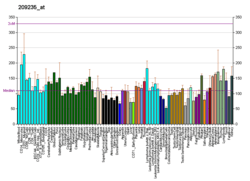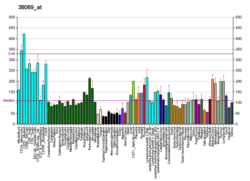CLCN7
Chloride channel 7 alpha subunit also known as H+/Cl− exchange transporter 7 is a protein that in humans is encoded by the CLCN7 gene.[5] In melanocytic cells this gene is regulated by the Microphthalmia-associated transcription factor.[6][7]
Clinical significance
Mutations in the CLCN7 gene have been reported to be associated with autosomal dominant osteopetrosis type II, a rare disease of bones.[8]
See also
References
- GRCh38: Ensembl release 89: ENSG00000103249 - Ensembl, May 2017
- GRCm38: Ensembl release 89: ENSMUSG00000036636 - Ensembl, May 2017
- "Human PubMed Reference:". National Center for Biotechnology Information, U.S. National Library of Medicine.
- "Mouse PubMed Reference:". National Center for Biotechnology Information, U.S. National Library of Medicine.
- "Entrez Gene: CLCN7 chloride channel 7".
- Meadows NA, Sharma SM, Faulkner GJ, Ostrowski MC, Hume DA, Cassady AI (2007). "The expression of Clcn7 and Ostm1 in osteoclasts is coregulated by microphthalmia transcription factor". J. Biol. Chem. 282 (3): 1891–904. doi:10.1074/jbc.M608572200. PMID 17105730.
- Hoek KS, Schlegel NC, Eichhoff OM, Widmer DS, Praetorius C, Einarsson SO, Valgeirsdottir S, Bergsteinsdottir K, Schepsky A, Dummer R, Steingrimsson E (2008). "Novel MITF targets identified using a two-step DNA microarray strategy". Pigment Cell Melanoma Res. 21 (6): 665–76. doi:10.1111/j.1755-148X.2008.00505.x. PMID 19067971.
- Coudert AE, Del Fattore A, Baulard C, Olaso R, Schiltz C, Collet C, Teti A, de Vernejoul MC (2014). "Differentially expressed genes in autosomal dominant osteopetrosis type II osteoclasts reveal known and novel pathways for osteoclast biology" (PDF). Lab. Invest. 94 (3): 275–85. doi:10.1038/labinvest.2013.140. PMID 24336069.
Further reading
- Brandt S, Jentsch TJ (1996). "ClC-6 and ClC-7 are two novel broadly expressed members of the CLC chloride channel family". FEBS Lett. 377 (1): 15–20. doi:10.1016/0014-5793(95)01298-2. PMID 8543009.
- Héon E, Piguet B, Munier F, et al. (1996). "Linkage of autosomal dominant radial drusen (malattia leventinese) to chromosome 2p16-21". Arch. Ophthalmol. 114 (2): 193–8. doi:10.1001/archopht.1996.01100130187014. PMID 8573024.
- Lennon G, Auffray C, Polymeropoulos M, Soares MB (1996). "The I.M.A.G.E. Consortium: an integrated molecular analysis of genomes and their expression". Genomics. 33 (1): 151–2. doi:10.1006/geno.1996.0177. PMID 8617505.
- Eggermont J (1998). "The exon-intron architecture of human chloride channel genes is not conserved". Biochim. Biophys. Acta. 1397 (2): 156–60. doi:10.1016/s0167-4781(98)00014-1. PMID 9565675.
- White KE, Koller DL, Takacs I, et al. (1999). "Locus heterogeneity of autosomal dominant osteopetrosis (ADO)". J. Clin. Endocrinol. Metab. 84 (3): 1047–51. doi:10.1210/jc.84.3.1047. PMID 10084593.
- Daniels RJ, Peden JF, Lloyd C, et al. (2001). "Sequence, structure and pathology of the fully annotated terminal 2 Mb of the short arm of human chromosome 16". Hum. Mol. Genet. 10 (4): 339–52. doi:10.1093/hmg/10.4.339. PMID 11157797.
- Kornak U, Kasper D, Bösl MR, et al. (2001). "Loss of the ClC-7 chloride channel leads to osteopetrosis in mice and man". Cell. 104 (2): 205–15. doi:10.1016/S0092-8674(01)00206-9. PMID 11207362.
- Cleiren E, Bénichou O, Van Hul E, et al. (2002). "Albers-Schönberg disease (autosomal dominant osteopetrosis, type II) results from mutations in the ClCN7 chloride channel gene". Hum. Mol. Genet. 10 (25): 2861–7. doi:10.1093/hmg/10.25.2861. PMID 11741829.
- Harada K, Toyooka S, Maitra A, et al. (2002). "Aberrant promoter methylation and silencing of the RASSF1A gene in pediatric tumors and cell lines". Oncogene. 21 (27): 4345–9. doi:10.1038/sj.onc.1205446. PMID 12082624.
- Strausberg RL, Feingold EA, Grouse LH, et al. (2003). "Generation and initial analysis of more than 15,000 full-length human and mouse cDNA sequences". Proc. Natl. Acad. Sci. U.S.A. 99 (26): 16899–903. doi:10.1073/pnas.242603899. PMC 139241. PMID 12477932.
- Campos-Xavier AB, Saraiva JM, Ribeiro LM, et al. (2003). "Chloride channel 7 (CLCN7) gene mutations in intermediate autosomal recessive osteopetrosis". Hum. Genet. 112 (2): 186–9. doi:10.1007/s00439-002-0861-9. PMID 12522560.
- Waguespack SG, Koller DL, White KE, et al. (2004). "Chloride channel 7 (ClCN7) gene mutations and autosomal dominant osteopetrosis, type II". J. Bone Miner. Res. 18 (8): 1513–8. doi:10.1359/jbmr.2003.18.8.1513. PMID 12929941.
- Frattini A, Pangrazio A, Susani L, et al. (2004). "Chloride channel ClCN7 mutations are responsible for severe recessive, dominant, and intermediate osteopetrosis". J. Bone Miner. Res. 18 (10): 1740–7. doi:10.1359/jbmr.2003.18.10.1740. PMID 14584882.
- Ota T, Suzuki Y, Nishikawa T, et al. (2004). "Complete sequencing and characterization of 21,243 full-length human cDNAs". Nat. Genet. 36 (1): 40–5. doi:10.1038/ng1285. PMID 14702039.
- Henriksen K, Gram J, Schaller S, et al. (2004). "Characterization of Osteoclasts from Patients Harboring a G215R Mutation in ClC-7 Causing Autosomal Dominant Osteopetrosis Type II". Am. J. Pathol. 164 (5): 1537–45. doi:10.1016/S0002-9440(10)63712-1. PMC 1615650. PMID 15111300.
- Gerhard DS, Wagner L, Feingold EA, et al. (2004). "The Status, Quality, and Expansion of the NIH Full-Length cDNA Project: The Mammalian Gene Collection (MGC)". Genome Res. 14 (10B): 2121–7. doi:10.1101/gr.2596504. PMC 528928. PMID 15489334.
- Köttgen M, Benzing T, Simmen T, et al. (2005). "Trafficking of TRPP2 by PACS proteins represents a novel mechanism of ion channel regulation". EMBO J. 24 (4): 705–16. doi:10.1038/sj.emboj.7600566. PMC 549624. PMID 15692563.
- Pettersson U, Albagha OM, Mirolo M, et al. (2006). "Polymorphisms of the CLCN7 gene are associated with BMD in women". J. Bone Miner. Res. 20 (11): 1960–7. doi:10.1359/JBMR.050717. PMID 16234969.
- Kornak U, Ostertag A, Branger S, et al. (2006). "Polymorphisms in the CLCN7 gene modulate bone density in postmenopausal women and in patients with autosomal dominant osteopetrosis type II". J. Clin. Endocrinol. Metab. 91 (3): 995–1000. doi:10.1210/jc.2005-2017. PMID 16368748.
- Olsen JV, Blagoev B, Gnad F, et al. (2006). "Global, in vivo, and site-specific phosphorylation dynamics in signaling networks". Cell. 127 (3): 635–48. doi:10.1016/j.cell.2006.09.026. PMID 17081983.
External links
- GeneReviews/NCBI/NIH/UW entry on CLCN7-Related Osteopetrosis
- CLCN7+protein,+human at the US National Library of Medicine Medical Subject Headings (MeSH)
- Human CLCN7 genome location and CLCN7 gene details page in the UCSC Genome Browser.
This article incorporates text from the United States National Library of Medicine, which is in the public domain.
This article is issued from Wikipedia. The text is licensed under Creative Commons - Attribution - Sharealike. Additional terms may apply for the media files.






